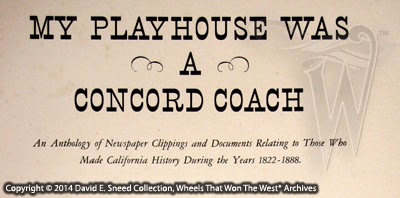Over the lasttwo decades, we’ve been fortunate to build a sizeable library of wood-wheeled transportationreferences. From original photography to primary source literature, correspondence, signage, and the vehicles themselves, each elementholds the potential of revealing significant information for restoration,identification, provenance, and overall research projects.
One of the trulyspecial books in our collection is a volume we’ve briefly listed before. It’s a huge labor of love unveiled almostthree quarters of a century ago. In1942, Mae Hélène Bacon Boggs published acompilation of early newspaper writings primarily related to stage coaching inthe American West. The title of theoversized and very thick tome is “My Playhouse Was A Concord Coach.” It’s an intriguing label further explained bythe author in the opening pages of the book.
When asked why she wrote the book, Ms.Boggs shares in the introduction, “I did not write a book but compiled a bookof those who made California history, placing it in the path of those whofollow, hoping that they, too, will leave it just a little better for havingtraveled this road.”
Well said - and, with that, we hope throughour writings, travels, and research we’re also able to leave things a littlebetter than we found them.
 |
| The book, “My Playhouse Was A ConcordCoach,” provides impressive historical insights into the business and operationof stage coaches in the American West. |
If you’re lucky enough to come acrossone of these original books, it will likely run you a few hundred dollars forthe privilege of owning it. Nonetheless,if you enjoy early western history and stagecoaches, it’s a wonderful piece tohave in your library. At 763 pages inlength, it’s a safe bet it will take some time to commit it to memory. We all owe a debt of gratitude to Ms. Boggsfor her tremendous dedication to this volume. In tribute to this massive and classic collection of western staging history, beloware a few excerpts from the work…
Yreka Journal - Wednesday,June 24, 1874
“The C. & O. (California &Oregon) Stage Co. are putting up another shop, near their stable in town, inwhich the wood work, and wood repairs of their coaches and wagons will beattended to, which with the blacksmith shop built last year, will enable thecompany to do all their own stage work by employing mechanics to take charge ofthe shops…”
New Hampshire Statesman – Friday, April17, 1868
“One of the most pleasing sights, in amechanical point of view ever seen in Concord was enjoyed on Wednesday. At 1 P.M., a large company of peopleassembled near the Freight House of the Concord R.R., where thirty elegantcoaches from the establishment of Abbot, Downing & Co., stood upon platformcars, about to depart for Omaha. Therunning portion of each vehicle is yellow, the body a rich red. Each bore the firm name of ‘WELLS, FARGO& CO.’ The ornamental painting onthe doors and other portions of the body of each is very beautiful. The coaches were all in line, with nointervening freight. At a few minutespast 1 the locomotive “Pembroke” gave a premonitory puff, and the beautifultrain passed off. It was made up toundergo no change until the coaches reach Omaha. The train was photographed by Benj. Carr…”
Shasta Courier – Saturday,November 21, 1863
“… The CALIFORNIA STAGE COMPANY havereceived one of their new style sleighs for use on Scott Mountain soon as thesnows require a change from wheel to runners. We have lived in snow country for many years but have never seen a snowvehicle of the pattern here presented. The runners are six inches wide, shod with steel half an inchthick. In the center of each runner, andmidway the body of the sleigh, are two bars of iron, one inch in diameter,which pass down through the runners, and are worked with the usual appliancesattached to brakes upon a coach, and the pressure of the feet upon the brakestrap forces the bolts through the runners into the snow, and thus checks itsprogress. The seats are arranged inregular omnibus style. It is a novel yetdurable snow craft for mountain travel.”
Shasta Republican – October 2,1858
“Wednesday last, on his last trip,Davis, one of the messengers of Wells, Fargo & Co., saved some lives andthe wreck of a coach. The driver haddismounted at the Blue Tent for the purpose of watering the horses – entrustingthe lines to a passenger who was sitting beside him. The horses soon started, when the person whoheld the reins jumped from the coach, and the team broke into a run. Davis had been sleeping under the driver’sseat, and being soon awakened, he at once perceived the perilous condition ofaffairs. He immediately climbed down tothe tongue of the coach and from thence to the back, and finally to the neck ofthe wheel horse, and succeeded in gathering up the flying reins of the leaders,and stopping the team…”
The excitement of the early Westcertainly kept the nation talking. Thecountry was big and so were the stories. Today, we continue to celebrate the determination and spirit of thoseearly pioneers and argonauts. The vastmajority were everyday people with extraordinary dreams. From cattle drives and military expeditionsto overland freighting, community growth, family ambitions, and countless otherventures, we’re continually reminded that the history and heritage that Americapossesses is unique and dramatic. Drivenby a desire for freedom, opportunity, and a better life, we still carry the samebasic DNA of our emigrant ancestors. Withthat in mind and before I close this week’s blog, I thought I’d share one otherentry compiled in this book. Carried bythe Shasta Courier at the close of the Civil War, it’s a reminder of what thepeople considered to be their strongest foundation – even amongst the greatestof trials…
Shasta Courier – Saturday, May20, 1865
“The GOVERNMENT has decided that themotto, “In God is our trust,” shall hereafter be stamped upon coin issued fromthe United States Mints. This is aproper recognition of the Great Creator, who has so wonderfully shaped thedestinies of this nation, and preserved it from dangers human foresight andhuman strength could not have averted.”